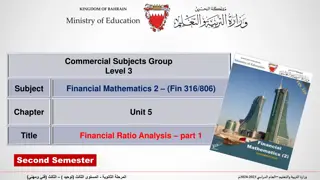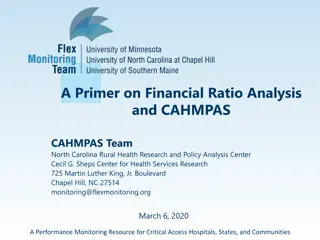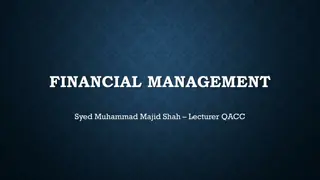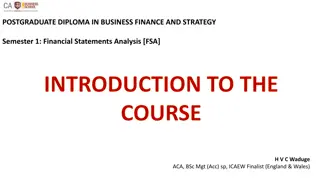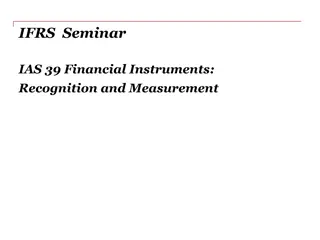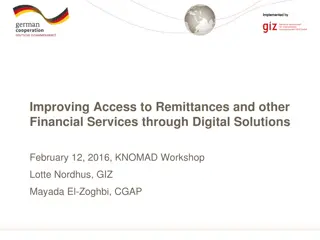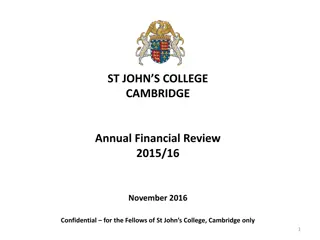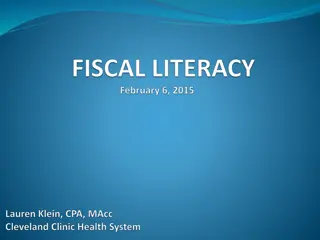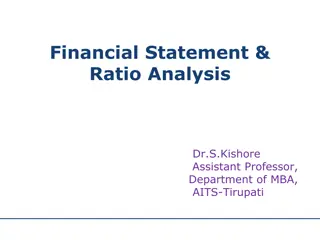Understanding Financial Objectives in Business
Explore the importance of setting financial objectives in business, including the value they bring, examples of objectives such as increasing revenue and reducing debt, and the distinction between cash flow and profit. Financial objectives help businesses focus, measure success, reduce risks, and plan for growth. By understanding the essence of financial objectives, businesses can make informed decisions to drive financial success.
Download Presentation

Please find below an Image/Link to download the presentation.
The content on the website is provided AS IS for your information and personal use only. It may not be sold, licensed, or shared on other websites without obtaining consent from the author. Download presentation by click this link. If you encounter any issues during the download, it is possible that the publisher has removed the file from their server.
E N D
Presentation Transcript
Croeso | Welcome to ABS Level 3 Business Lecture Series
Setting Financial Objectives Focus- Cash Flow Content to support Level 3 Business Emma Davies (emd31@aber.ac.uk)
Learning Outcomes Understanding of financial objectives The value of setting financial objectives. The distinction between cash flow and profit. Cash flow objectives. The cash flow statement The cash flow forecast
Understanding of financial objectives What is a financial objective? Is part of the financial planning process of a business. Targets of a business that can be expressed in monetary terms within a set timescale. Financial objectives are different from other types of objectives.
The value of setting financial objectives Acts as a focus for senior management and departments of a business. Measurement tool: Against previous years, targets, competitors etc. Improves coordination and efficiency. Shareholders and other Stakeholders are able to assess the financial viability of a company.
The value of setting financial objectives Identify and reduce risks. Anticipate future challenges and threats. Greater control over your budget and provides valuable data to aid decision making. Enables a business to grow and increase market share.
Examples of financial objectives Increase annual revenue by 10% per annum. Achieve a profit margin of 20% by 2021. Reduce stock levels. Maintain a positive cash flow. Exploit new markets to increase sales. Purchase new fixed assets to increase efficiencies and reduce overhead costs. Reduce level of debt.
The distinction between cash flow and profit Cash and profit are related BUT are not the same! Cash is an asset to a business and can be measured at a particular point in time. Profit can only be earned and measured over time.
The distinction between cash flow and profit The difference between them depends on the source of the cash transactions and the basis of accounting.
The Cash Flow Statement Part of the financial statements. A summary of the amount of cash coming in and out of the company. Measures how efficient a company is in managing its cash position. Identifies how well a business generates cash to fund its operating expenses and debt obligations.
The Cash Flow Statement Made up of three parts: 1. Revenue / Income 2. Expenses / Outgoings 3. Balances
The Cash Flow Statement Revenue Income received by a business for goods or services provided. This revenue can often be split into cash sales and debtor payments.
The Cash Flow Statement Expenses All the money spent by a business within the time period is shown under expenses. Expenses are broken down within the cash flow to see where the money is being spent. Examples of expenses could include: Wages, electricity, rent, stationary etc.
The Cash Flow Statement Calculating net cash flow = Total Revenue Total Expenses Revenue > Expenses = + cash flow Revenue < Expenses = - cash flow
The Cash Flow Statement Closing balances Each period has an opening balance that has been carried forward from the previous period. This opening balance represents is the amount of cash available at the beginning of the period. The net cash flow is added or deducted from this opening balance to form the closing balance.
The Cash Flow Statement Example January Total Revenue 1,200 Total expenses 4,900 Net cash flow - 3,700 (Revenue Expenses)
The Cash Flow Statement Example January February March Opening balance - 3,700 - 5,360 +/- Net cash flow - 1,660 - 700 Closing balance - 3,700 - 5,360 - 6,060
The Cash Flow Statement The cash flow forms part of the financial statements and is a historic document. Cash flow statements are also used to forecast future periods, investments or particular scenarios.
The Forecasted Cash Flow Statement Predict the likely flows of cash into and out of the period. Based on: Past experience Current and expected future economic and financial trends Knowledge and understanding of managers
The Cash Flow Statement A business actual cash flow statement can differ considerably from its cash flow forecast. Why?
The Cash Flow Statement Fashions Economic climate Finance ChangePolitics Competition Technology
The Cash Flow Forecast Typical reasons for cash flow forecast issues: Actual sales differ from expected level Costs increase Internal factors Inadequate or poor quality information
The Cash Flow Forecast Typical reasons for cash flow forecast issues: Actual sales differ from expected level Costs increase Internal factors Inadequate or poor quality information
The Cash Flow Forecast All business should monitor cash flow regularly. Examine deviances between actual and forecasted figures. With experience, the accuracy of forecasting should improve. The forecast should tell a business if they have sufficient funds to pay future expenses.
The Cash Flow Forecast Solutions to predicted cash shortage: Increase revenue Reduce costs Delay payment Additional funding Invoice factoring
Cash Flow Objectives Evaluates cash position. Ensure future positive cash flow. Ensure the ability to pay dividends. Picture of liquidity position. Comparison with previous years. Provides greater detail and clarifies areas of concern.
Cash Flow Objectives Examples Reduce bank borrowings and over drafts to a targeted level. Reduce average debtor day ratio. Increase average creditor day ratio effectively. Develop a rainy day fund. Stabilise cash flow and reduce peaks and troughs during the period.
Limitations of a cash flow forecast Time consuming to prepare and monitor To have value cash flow forecast must be accurate. The longer the timeframe, the less accurate the cash flow forecast will be. Rate of inflation can impact the figures. Not all information maybe shared.
Activities Edexcel Winter 2010 paper. Questions 7, 9, 10 and 11 (30 minutes) Multiple choice questions







